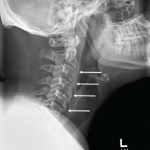Detailed paleontological studies demonstrated a high degree of prevalence of DISH in the Medici clan, suggesting an association between DISH and elite status. Further studies have linked DISH with a high-caloric diet, obesity, and type 2 diabetes mellitus. The Italian Renaissance aristocratic classes had access to a wide variety of foods. Historical data and carbon isotope dating reveal that their diet was primarily based on wine and meat, occasionally enriched by eggs and cheese and, on penitential occasions, by fish. In contrast, the consumption of vegetables was scarce and fruit was almost never eaten. Not surprisingly, several of the DISH-afflicted members of the Medici family were also found to have suffered from gout. Ouch.
If you look hard enough, you will find DISH in many other famous remains including the Egyptian pharaoh Ramses II and in hominid specimens as old as the Neandertal Shanidar I, who lived approximately 50,000 years ago. Our colleague, Bruce Rothschild, working with anthropologists from the University of Nevada, has identified DISH in the skeletal remains of about one in eight Nubian males who resided in northern Sudan a few thousand years ago. The Nubians were a nomadic tribe of hunters and gatherers. They had access to food, and archeological evidence suggests that they were well nourished. Being well fed is a recurrent theme in the DISH story. Dr. Rothschild has suggested that there may have been an evolutionary benefit to having DISH. The paravertebral bone deposition could have protected the host against the development of neuroforaminal narrowing by providing additional bracing support to the aging spine. In a world of kill or be killed, undoubtedly it was far more advantageous to have DISH than lumbar spinal stenosis.
Metabolic Factors
An intriguing study by Juliet Rogers and Tony Waldron found DISH to be present in six out of 52 excavated males of the population buried in the church and chapels from The Royal Mint Medieval site in London, while the prevalence of DISH in a nearby lay cemetery where the general population (likely to be peasants and farmers)was buried was zero out of 99 males. They suggested that this disparity was due to a difference in occupation and social class resulting indifferent diets. Similar findings have been noted in studies of Dutch clergy. Prior descriptions of the dietary habits of monks in the Middle Ages indicate that saturated (animal) fats combined with small portions of vegetables and ample alcoholic beverages were frequently on the menu, not unlike the current diet in many Western societies.

